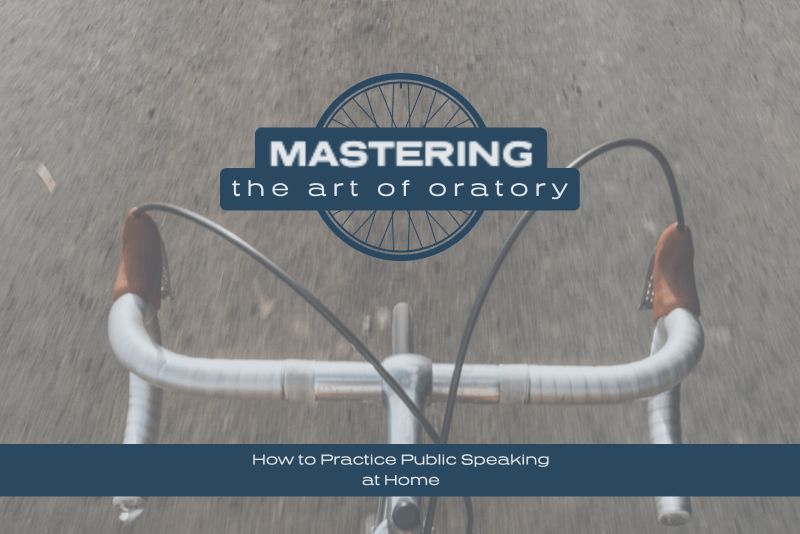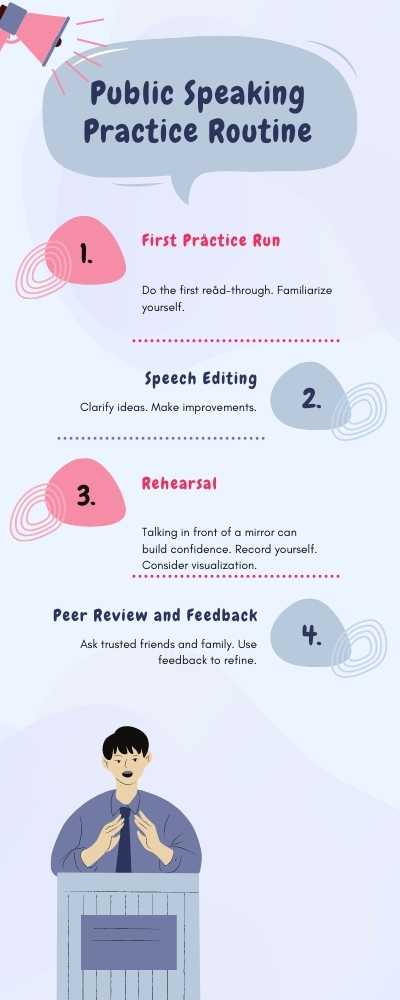HOW TO PRACTICE PUBLIC SPEAKING AT HOME
Speaking confidently in public is a valuable asset but can also be daunting to many. However, like any other skill, practice can improve public speaking. In this blog post, we will provide you with comprehensive techniques on how to practice public speaking at home, turning your living room into a personal stage for your oratory development.

Table of Contents:
- Techniques to Effectively Practice Public Speaking at Home
- Establishing a Home-Based Practice Routine
- Utilizing Technology for Virtual Public Speaking
- The Role of Feedback in Improving Public Speaking
- Emulating Successful Public Speakers
- The Power of Visualization
- Wrap-Up
Techniques for Effective Public Speaking at Home
Effective public speaking relies on several techniques. Practice the techniques that follow as part of your home-based routine:
- Content Preparation: It's essential to understand your topic thoroughly. Research and organize your content, and create an engaging introduction, a structured body, and a compelling conclusion.
- Voice Modulation: Varying the pitch, tone, volume, and speed of your speech can make your delivery more engaging. Practice different modulation techniques to prevent a monotone delivery.
- Body Language: Non-verbal cues often communicate more than words. Work on your posture, hand gestures, facial expressions, and eye contact.
- Overcoming Nervousness: Try relaxation techniques like deep breathing, visualization, or progressive muscle relaxation to manage performance anxiety.
Establishing a Home-Based Practice Routine
Creating a routine is the first step to practice public speaking at home. Find a quiet, comfortable space to serve as your "stage." You can practice in front of a mirror to observe your body language, facial expressions, and gestures. Next, allocate a specific time each day for your practice. Consistency delivers the best results; even 15 minutes daily can lead to significant improvements over time.
A comprehensive, step-by-step routine you can follow to develop, practice, and perfect a public speech at home.
1. Topic Selection and Research (Day 1-3)
Choose a topic that interests you or that you're knowledgeable about. Spend a few days researching it thoroughly. Understand various perspectives, gather relevant facts and statistics, and identify critical points you want to include in your speech.
2. Speech Writing (Day 4-6)
Start by outlining your speech. Divide it into three sections: introduction, body, and conclusion. Write your speech keeping your audience in mind. Use simple and straightforward language. Incorporate storytelling and thematic elements to make your speech more engaging.
3. First Practice Run (Day 7)
Do a first read-through of your speech. Don't worry about delivery at this point. This run is to familiarize yourself with your speech's flow and identify awkward phrases or transitions.
4. Speech Editing (Day 8)
Based on your first practice run, edit your speech. Look for areas where you can clarify ideas, improve transitions, or make your language more impactful.
5. Rehearsal (Day 9-14)
Spend the next few days in rehearsal and in the physical practice of public speaking at home. How?
- Practice in front of a mirror to observe your body language and gestures.
- Record yourself to review your vocal delivery, pace, and tone.
- Focus on one improvement area daily, such as eye contact, vocal modulation, or pacing.
- Begin visualization exercises focused on the improvement goal for the day.
6. Peer Review (Day 15)
Ask a trusted friend or family member to listen to your speech and provide feedback. This can give you insights into how your audience might perceive your speech.
7. Incorporate Feedback (Day 16-18)
Use the feedback to refine your speech and delivery. Make necessary changes in your script and consider the delivery elements highlighted during the peer review. Continue visualization techniques focused on the delivery element highlighted for improvement.
8. Final Rehearsals (Day 19-21)
In the final days leading up to your speech, practice delivering it without reading from your script. This can help improve your confidence and make your delivery seem more natural. If the circumstances do not permit physical rehearsal, incorporate visualization exercises to gain many of the same benefits.
9. Day of the Speech (Day 22)
On the day of your speech, warm up your voice and do relaxation exercises to manage anxiety. Go through your speech, then trust yourself and your preparation.
Remember, this routine is just a guideline, and you can adjust it based on your needs and availability. Regular practice and feedback are the keys to improving your public speaking skills.
Utilizing Technology for Virtual Public Speaking
Technology can be an excellent ally for practicing public speaking at home in this digital age. Recording yourself can provide insights into your strengths and areas for improvement. Moreover, online platforms like Zoom or Google Meet allow you to practice virtual public speaking, which has become increasingly relevant in our increasingly remote-work world.
The Role of Feedback in Improving Public Speaking
Practice makes perfect, but feedback makes practice worthwhile. Ask a trusted friend, family member, or willing teacher to observe your practice sessions and provide constructive criticism. You can also join a local Toastmasters club or use apps like Orai, which provide detailed feedback on various aspects of your public speaking. Embrace constructive criticism.
Feedback, as mentioned, is invaluable in improving your public speaking skills. It's crucial to embrace constructive criticism and not take it personally. Understand that criticism helps you grow and does not undermine your efforts. People willing to hear your speech either love, admire, or value you. Therefore, incorporate your feedback based on its meaningfulness and work on improving those areas in your subsequent practice sessions.
Emulating Successful Public Speakers
Another effective way to practice public speaking at home is by learning from the best. Watch TED Talks, speeches by leaders, or stand-up comedy routines. Notice how they engage the audience, use humor, tell stories, and employ pauses. Try to incorporate some of these strategies into your speeches.
The Power of Visualization
Visualization is a powerful technique used by many successful public speakers. Picture yourself delivering a successful speech with a receptive audience and a confident demeanor. This technique can help reduce anxiety and improve performance.
Visualization is not faux science. There is substantial scientific evidence supporting the effectiveness of visualization (also known as mental rehearsal or imagery) for improving performance in various domains, including public speaking. It's important to note that while many studies suggest a positive correlation, the exact mechanisms and effectiveness can vary between individuals and contexts.
The theory underlying the use of visualization techniques is rooted in neuroscience. The premise is that the brain can't distinguish between a vividly imagined experience and a real one. This means that mentally rehearsing a speech, for example, you can train your brain to be more comfortable and effective in actual public speaking scenarios.
Published studies found that individuals who used visualization techniques reported less anxiety, performed better, and were perceived more positively by others during a public speaking task. Studies also found that people who visualized themselves from a third-person perspective (seeing themselves perform well in their mind's eye) were likelier to feel confident and perform effectively in a subsequent public speaking task.
- Joe Ayres & Tim Hopf (1992) Visualization: Reducing speech anxiety and enhancing performance, Communication Reports, 5:1, 1-10, DOI: 10.1080/08934219209367538. https://doi.org/10.1080/08934219209367538
- Ebrahimi, O. V., Pallesen, S., Kenter, R. M., & Nordgreen, T. (2019). Psychological Interventions for the Fear of Public Speaking: A Meta-Analysis. Frontiers in Psychology, 10. https://doi.org/10.3389/fpsyg.2019.00488
However, remember that visualization techniques are most effective when used as a part of a comprehensive approach to skill development. This includes physical practice, feedback, relaxation techniques, and other strategies for performance enhancement.
For the most current and comprehensive information on this topic, I recommend reviewing more recent literature or consulting experts in psychology and neuroscience.
An April 23, 2023 episode of Huberman Lab covered the visualization topic in detail, and the host Andrew Huberman, Ph.D. of Stanford School of Medicine, included multiple links to supporting evidence. Listen to the episode to understand more about incorporating visualization into your home-based public speaking practice.
Wrap-Up - How to Practice Public Speaking at Home

In conclusion, practicing public speaking at home can be a game-changer for your communication skills. You can significantly enhance your oratory prowess through a dedicated practice routine, the application of effective speaking techniques, the use of technology, and valuable feedback. If you wish to delve deeper into public speaking, consider enrolling in online courses, reading books like "Talk Like TED" by Carmine Gallo, or attending workshops on public speaking. Remember, becoming an effective public speaker is a journey of constant learning and practice.
[Full disclosure: Best Speech Topics is a compensated affiliate of Amazon.]
Remember, Rome wasn't built in a day, and neither is a great public speaker. Patience and persistence are essential in this process. You might not see immediate results, but don't let that discourage you. With each passing day, you're making progress, even just a little. You're stepping out of your comfort zone, gaining confidence, and honing your skills.

